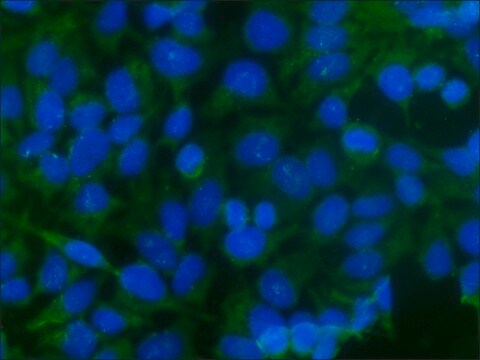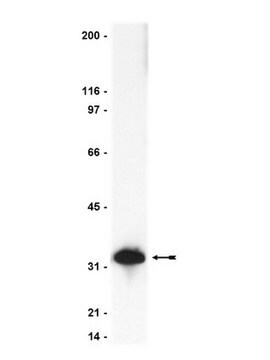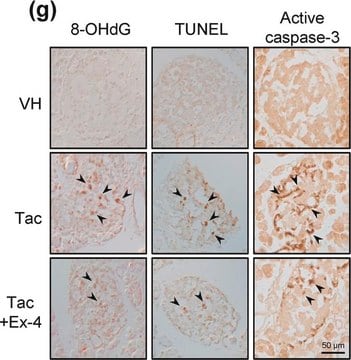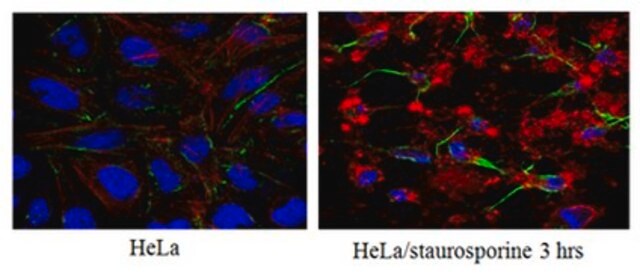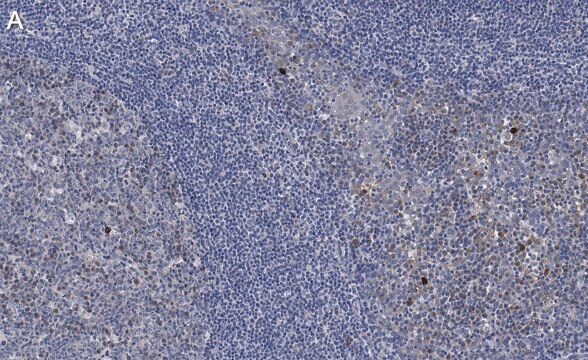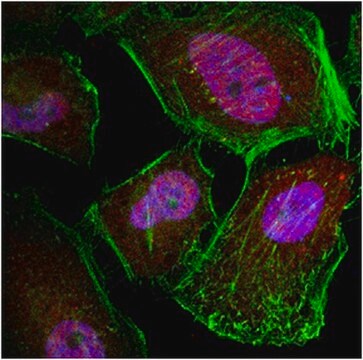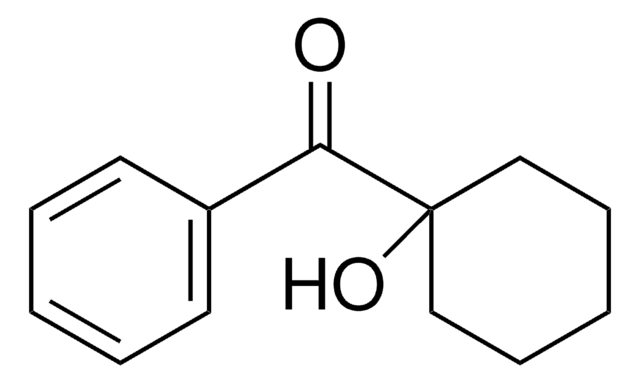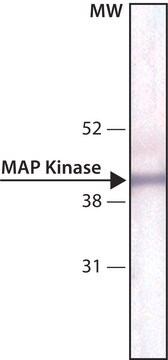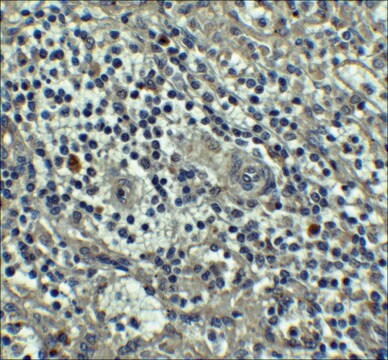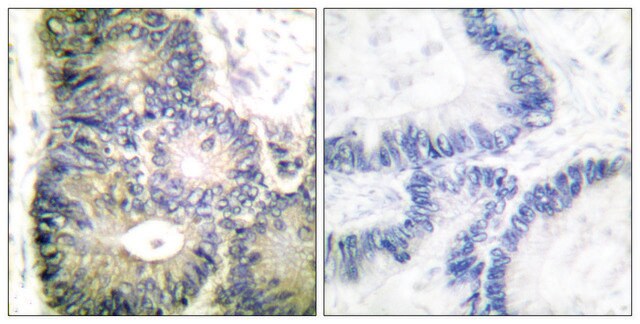C5737
Monoclonal Anti-Caspase 3 antibody produced in mouse
clone 84803.111, purified immunoglobulin, lyophilized powder
Sinônimo(s):
Anti-Apopain, Anti-CPP32, Anti-Yama
Faça loginpara ver os preços organizacionais e de contrato
About This Item
Produtos recomendados
fonte biológica
mouse
Nível de qualidade
conjugado
unconjugated
forma do anticorpo
purified immunoglobulin
tipo de produto de anticorpo
primary antibodies
clone
84803.111, monoclonal
Formulário
lyophilized powder
reatividade de espécies
human
técnica(s)
western blot: 1.0 μg/mL using human Jurkat cells
Isotipo
IgG2b
nº de adesão UniProt
temperatura de armazenamento
−20°C
modificação pós-traducional do alvo
unmodified
Informações sobre genes
human ... CASP3(836)
Categorias relacionadas
Descrição geral
CASP3 (caspase 3) is a cysteine protease belonging to the caspase protein family, and is related to interleukin-1β-converting enzyme (ICE). It is the human homologue of Caenorhabditis elegans Ced-3 protein. This protein forms a key element of apoptosis.
Especificidade
Detects recombinant human precursor caspase 3 and the 18 kDa form produced during apoptosis.
Imunogênio
recombinant 18 kDa subunit, amino acids 29-175, of human caspase 3.
Ações bioquímicas/fisiológicas
CASP3 (caspase 3) is an essential protein of apoptosis, which includes multiple death-inducing signals, and caspase 3 functions at the last steps of programmed cell death. This protein is shown to be expressed in esophageal squamous cell carcinoma (ESCC), and its down-regulation is related to increased malignancy and reduced overall survival. Its expression in metastatic lymph nodes (LN) might serve as a marker for poor survival prognosis in patients with resected ESCC and metastasis to LN. Studies in multiple cancers such as, gastric, colorectal, ovarian and cervical cancers show that aberrant expression of this gene is linked with cancer progression and aggressive behavior. It might have potential as a marker to determine the prognosis of the above cancers.
forma física
Lyophilized from a 0.2 μm filtered solution in 0.01 M phosphate buffered saline with 5% trehalose.
Exoneração de responsabilidade
Unless otherwise stated in our catalog or other company documentation accompanying the product(s), our products are intended for research use only and are not to be used for any other purpose, which includes but is not limited to, unauthorized commercial uses, in vitro diagnostic uses, ex vivo or in vivo therapeutic uses or any type of consumption or application to humans or animals.
Não está encontrando o produto certo?
Experimente o nosso Ferramenta de seleção de produtos.
recomendado
Nº do produto
Descrição
Preços
Código de classe de armazenamento
11 - Combustible Solids
Classe de risco de água (WGK)
WGK 1
Ponto de fulgor (°F)
Not applicable
Ponto de fulgor (°C)
Not applicable
Escolha uma das versões mais recentes:
Já possui este produto?
Encontre a documentação dos produtos que você adquiriu recentemente na biblioteca de documentos.
Os clientes também visualizaram
Qian Hu et al.
International journal of clinical and experimental pathology, 7(8), 5057-5070 (2014-09-10)
Emerging evidence has indicated that apoptotic cells have a compensatory effect on the proliferation of neighboring cells. Recent studies have shown that apoptotic tumor cells stimulate the repopulation of tumors from a small number of surviving cells by cleaved caspase-3
Xiu-Shen Wang et al.
World journal of gastroenterology, 20(15), 4414-4420 (2014-04-26)
To assess whether differential expression of caspase-3 in paired metastatic lymph nodes (LNs) is prognostic of survival in patients with resectable esophageal squamous cell carcinoma (ESCC). Capases-3 expression was evaluated immunohistochemically in 122 pairs of primary ESCCs and regional metastatic
Tingting Gu et al.
Oncology letters, 14(6), 6815-6822 (2018-02-10)
The present study explored the expression of tetraspanin 1 (TSPAN1) in esophageal carcinoma (EC) and its association with clinicopathological factors. TSPAN1 small interfering RNA (siRNA) was designed to target the TSPAN1 gene in Eca-109 cells in order to explore the
Chuandong Zhu et al.
Oncology letters, 15(4), 4221-4228 (2018-03-20)
The high atomic number of gold nanoparticles (GNPs) enables them to offer potential as practical and efficient radiosensitizing agents for cancer radiotherapy applications. In the present study, it was demonstrated that GNPs can significantly modulate the irradiation response of hepatocellular
Javier Marqués et al.
Antioxidants (Basel, Switzerland), 11(11) (2022-11-12)
NADPH oxidases (NOX) constitute the main reactive oxygen species (ROS) source in blood vessels. An oxidative stress situation due to ROS overproduction can lead into endothelial dysfunction, a molecular mechanism that precedes cardiovascular diseases (CVDs) such as atherosclerosis, myocardial infarction
Nossa equipe de cientistas tem experiência em todas as áreas de pesquisa, incluindo Life Sciences, ciência de materiais, síntese química, cromatografia, química analítica e muitas outras.
Entre em contato com a assistência técnica